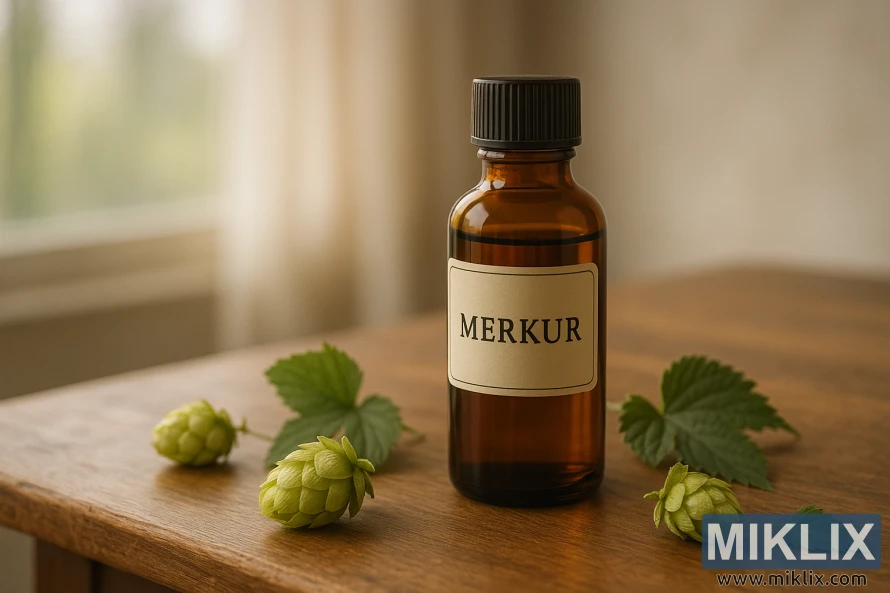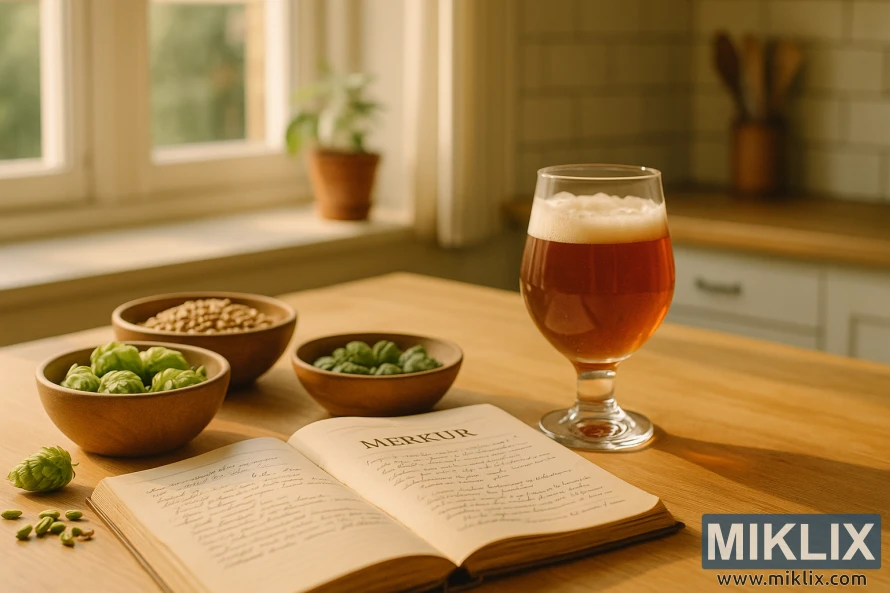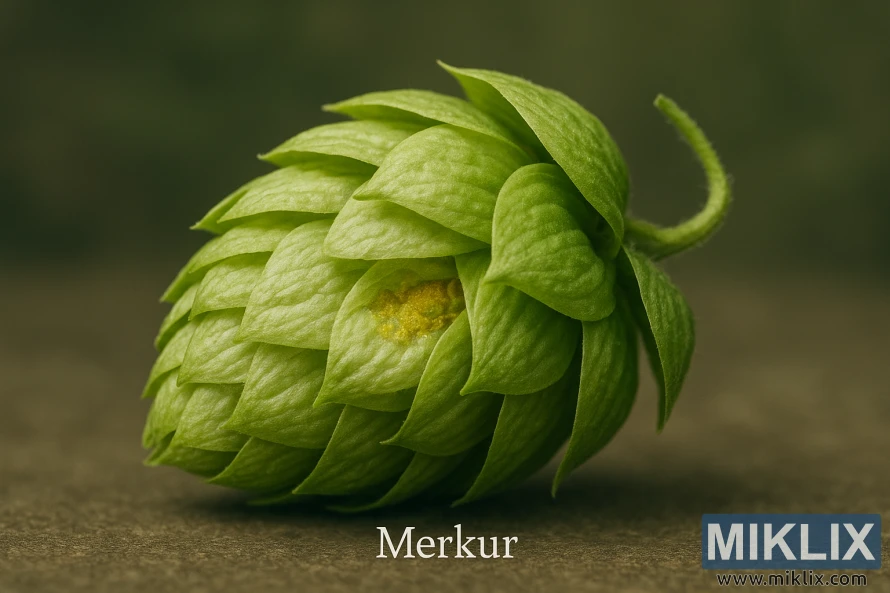Hops in Beer Brewing: Merkur
Published: November 19, 2025 at 12:31:38 AM UTC
Last updated: November 25, 2025 at 3:30:50 PM UTC
Hallertau Merkur, a modern German hop, has gained significant respect among brewers. Developed by the Hop Research Institute in Germany, it was introduced around 2000–2001. This hop combines Magnum parentage with an experimental German variety. It offers reliable alpha acids and a versatile Merkur hop profile.

For brewers, Merkur's strength is evident in early-to-mid boil additions. It provides clean bitterness. Later additions reveal a subtle citrus and earthy aroma. Its adaptability makes it suitable for a broad spectrum of beer styles. This includes crisp pilsners and lagers, as well as hop-forward IPAs and darker stouts. It's a practical choice for both homebrewers and craft professionals.
Key Takeaways
- Hallertau Merkur is a German dual-purpose hop released in the early 2000s.
- Merkur hops offer high alpha acids for bittering while remaining usable for aroma.
- Merkur brewing works well across many styles, including IPAs, lagers, and stouts.
- Common formats are pellets and whole-cone; lupulin powders are not widely available.
- Its flavor falls between citrus and earthy, making it versatile in recipes.
Overview of Merkur hops and their role in brewing
Merkur is a high-alpha, dual-purpose hop from Germany. This Merkur overview highlights why brewers prize its balance of bittering power and aromatic character.
Released around 2000–2001 and registered with the code HMR, Merkur joins the family of modern German hops developed for versatility. As one of the notable German hops, it fits both traditional lagers and modern ales.
Brewers use Merkur for bittering because its alpha acids commonly range from 12% to 16.2%, averaging near 14.1%. Those numbers make Merkur an efficient choice when you need predictable IBUs.
At the same time, the hop carries aromatic oils that show citrus, sugar, pineapple, mint, and a touch of earth. This profile allows for adding Merkur later in the boil or in whirlpool and dry-hop stages. It lifts aroma without losing bitterness.
The Hallertau Merkur role in recipes spans many styles. Brewers find it useful in IPA or pale ales for backbone and bright top notes. It's also great in pilsners and lagers for clean bittering with subtle fruit. Additionally, in Belgian ales or stouts, its nuance can complement malt and yeast.
- Alpha acid range: commonly 12–16.2% (average ~14.1%)
- Aroma notes: citrus, pineapple, sugar, mint, light earth
- Common uses: bittering, mid-boil additions, whirlpool, late additions
- Formats: whole cone and pellet hops sold by multiple suppliers
Availability varies by harvest year, price, and format. Many hop retailers ship nationally. So, you can source Merkur in whole-cone or pellet form depending on your recipe needs.
Genetics and lineage of Merkur
Merkur's origins date back to a German breeding program in the early 2000s. It carries the cultivar ID 93/10/12 and the international code HMR. The hop's lineage is a mix of Magnum's strong alpha acid traits and a German experimental variety, 81/8/13.
The Magnum influence is evident in Merkur's high alpha acid content. Breeders sought to preserve its bittering strength while retaining some aroma oils. The experimental parent adds a subtle aromatic layer, balancing out the bitterness.
References to Hallertau genetics highlight the German breeding context. Institutions like renowned hop programs were involved in selecting for balanced brewing traits. This background supports Merkur's role as a high-alpha hop with aromatic potential.
- Breeding goal: high-alpha bittering with aroma retention.
- Cultivar/brand: 93/10/12, international code HMR.
- Parentage: Magnum crossed with 81/8/13.
Merkur stands between pure bittering hops and dual-purpose varieties. It offers a Magnum-like backbone with aromatic nuances. This makes it ideal for brewers looking for a balanced hop without overpowering malt or yeast flavors.

Alpha and beta acids: bitterness profile
Merkur alpha acids typically range from 12.0% to 16.2%, averaging around 14.1%. These acids are crucial for wort bittering, especially during the early boil stages.
The alpha-to-beta ratio usually falls between 2:1 and 4:1, averaging 3:1. This ratio highlights the alpha acids' dominant role in bitterness, contrasting with the aroma-focused beta acids.
Beta acids Merkur range from 4.5% to 7.3%, averaging 5.9%. Unlike alpha acids, beta acids do not isomerize into bitterness during boiling. Instead, they contribute hop resin and volatile compounds as the beer ages.
Co-humulone Merkur levels are generally low to moderate, around 17%–20% of total alpha acids. This average of 18.5% contributes to a smoother, less harsh bitterness compared to hops with higher co-humulone percentages.
Practical brewing notes:
- Expect consistent Merkur bitterness when formulating IBUs, but check current alpha acid assays for seasonal shifts.
- Use Merkur alpha acids as a primary bittering hop; larger alpha values reduce the amount needed for target IBUs.
- Count on beta acids Merkur for late aroma and dry-hop resin contributions rather than boil isomerization.
- Factor co-humulone Merkur into bitterness perception; lower percentages favor smoother mouthfeel.
Adjust hop weight based on lab-reported alpha acids and adjust kettle schedule to balance bittering and aroma. Small changes in assay numbers can shift final IBUs, so a conservative margin helps reach the intended beer profile.
Essential oils and aroma chemistry
Merkur essential oils contain around 2.0–3.0 mL per 100 g of hops. Many samples cluster near 2.5–3.0 mL/100 g. This concentration is perfect for both early boil additions and late-stage aroma work.
The dominant compound in Merkur is myrcene, making up about 45%–50% of the oil. Myrcene contributes resinous, citrusy, and fruity notes, enhancing Merkur's bright top-end. Its high presence makes Merkur lively in whirlpool and dry-hop uses.
Humulene is another major component, accounting for roughly 28%–32% of the oil. It adds woody, noble, and mildly spicy tones. The balance between myrcene and humulene in Merkur creates an earthy base with a citrus lift.
- Caryophyllene: about 8%–10%, adds peppery and herbal depth.
- Farnesene: minimal, near 0%–1%, gives faint green and floral hints.
- Minor terpenes: β-pinene, linalool, geraniol and selinene together can total 7%–19%, offering floral and perfumed accents.
A simple hop oil breakdown reveals Merkur's versatility. High myrcene favors aroma extraction in late additions. Strong humulene retains woody and spicy character during boil and whirlpool stages.
Brewers aiming to highlight citrus and resin should focus on late kettle and dry-hop doses. Those seeking a stable backbone can use earlier additions. This allows humulene and caryophyllene to integrate with malt and yeast.

Flavor and aroma descriptors of Merkur
Merkur flavor is a blend of earthy and spicy bitterness, providing a solid foundation for beers. Early additions bring a herbal, slightly resinous bite, making it practical for pale ales and lagers. This characteristic is noted for its sturdy presence.
As additions progress, the flavor shifts towards bright citrus and sweet tropical notes. In whirlpool or dry-hop additions, Merkur's aroma reveals clear pineapple top notes with a subtle cooling mint edge. This pineapple mint Merkur trait is particularly useful for balancing malt sweetness.
Descriptive tasting notes include sugar, pineapple, mint, citrus, earthy, herbal, and spicy. The sweet aromatic aspect prevents the hop from feeling one-dimensional. In low-bitterness recipes, sugar and pineapple hints become more pronounced in test batches.
- Early boil: earthy and spicy bitterness dominates.
- Mid to late boil: citrus zest and light herbal tones emerge.
- Whirlpool/dry-hop: pronounced pineapple and mint highlights appear.
The balance between citrus zing and earthy depth allows Merkur to add structure without overwhelming the aroma. Brewers aiming for a complex hop profile use it to layer backbone bitterness with fruity, aromatic lifts.
Brewing applications and ideal addition timing
Merkur is a versatile hop, suitable for both bittering and adding a clean, citrusy flavor to beer. Brewers often choose Merkur for its ability to provide a solid bittering backbone and a hint of citrus.
For optimal results, add Merkur early in the boil. This ensures its high alpha acids contribute effectively to the beer's bitterness. Early additions are crucial for establishing a stable bitterness profile in ales and lagers.
Mid-boil additions of Merkur extract myrcene and humulene oils. These oils contribute to citrus and pineapple notes, enhancing the beer's flavor without overpowering the malt.
Adding Merkur in the late boil or whirlpool can introduce aroma, though the impact is modest. Whirlpool additions at lower temperatures help preserve volatile oils, resulting in a soft citrus aroma rather than a strong one.
Dry hopping with Merkur yields limited results compared to modern aroma hops. Due to its volatile nature, Merkur's oils are partially lost during boiling. Therefore, dry hopping requires higher quantities to achieve noticeable effects.
- For bittering: add at 60 minutes with alpha adjustment for variability (12–16.2%).
- For balanced flavor: add at 20–30 minutes to capture both bitterness and aroma.
- For late aroma: add in whirlpool at 70–80°C for a gentle citrus presence.
- For dry hop character: increase quantities and blend with a stronger aroma hop.
Cryo or lupulin concentrate forms of Merkur are not available. This limits the use of concentrated whirlpool and dry-hop techniques, which are common with brands like Yakima Chief. Recipes should be planned around whole cone or pellet formats, taking into account alpha variation.
When substituting hops, it's important to match their flavor profiles. Magnum is ideal for bittering. Hallertau Taurus or Tradition can be used for balanced additions, but adjust the rates to match the desired bitterness and IBUs.
Practical testing in small batches is essential for fine-tuning Merkur additions. Monitor the boil length, whirlpool temperature, and addition times to predict the beer's aroma and IBU levels in future brews.

Beer styles that highlight Merkur hops
Merkur hops are perfect for several classic beer styles, offering a firm bitterness with some aroma. In India Pale Ales, Merkur IPAs provide a bitter backbone and a fruity, citrus-myrcene flavor. Early additions of Merkur ensure clean IBUs, while late additions enhance the hop character without upsetting the balance.
In lagers and pilsners, Merkur adds a crisp, clean bitterness. A light touch of Merkur brings a subtle citrus and earthy flavor, complementing noble or Hallertau aroma hops. This approach keeps the beer restrained yet fresh.
Belgian ales benefit from Merkur's spicy and citrus notes, enhancing their complexity. These hops support estery yeast profiles, ensuring the beer feels more complex without overpowering malt or yeast. Adding Merkur mid to late preserves these delicate nuances.
Stouts also benefit from Merkur as a firm bittering hop, balancing roast and malt sweetness. It adds a faint herbal or citrus hint that brightens the finish. Use measured additions to avoid clashing with chocolate and coffee tones.
- IPAs: Merkur IPAs as primary bittering hop, with complementary aroma hops.
- Lagers/Pilsners: Merkur in lagers for subtle lift when balanced with noble varieties.
- Belgian ales: adds spicy-citrus facets to estery profiles.
- Stouts: bittering hop that adds herbal-citrus clarity to rich malts.
The versatility of Hallertau Merkur styles makes it a valuable option for brewers seeking a German high-alpha hop. It retains some aroma character when used with care. Test small batches to find the perfect balance that showcases Merkur without masking the base beer's qualities.
Practical brewing values and recipe guidance
Alpha acid Merkur at 14.1% is a good starting point for recipe math when lab data is missing. It typically ranges from 12.0%–16.2%. Update Merkur IBUs once you confirm the alpha acid Merkur from your supplier.
For bittering additions, treat Merkur as a primary hop. Adjust usage rates downward if your lot's alpha acid is near the upper range to avoid bitterness. Its co-humulone of about 18.5% provides a smooth, rounded bittering character.
For flavor additions, expect herbal and citrus notes. Use moderate Merkur rates to add structure without overpowering malt complexity. Track Merkur IBUs from both boil concentration and mash factors to calculate perceived bitterness.
For aroma and whirlpool additions, late Merkur additions bring out pineapple, mint, and citrus. Total oil content near 2.5–3.0 mL/100g means aroma impact is real but less volatile than specialized aroma hops. Consider slightly larger late additions for stronger presence.
Dry hopping with Merkur is possible but less common. If you choose to dry hop, increase the amount relative to a purpose-bred aroma hop to reach desired notes. Beta acids (about 4.5%–7.3%) matter for aroma longevity and aging behavior, not for immediate IBUs.
- Example role: use Merkur as the bittering base in a German-style IPA or a lager.
- Pairing: combine Merkur with Citra or Mosaic for fruity IPAs, or with Hallertau Tradition for classic lagers.
- Substitutes: Magnum, Hallertau Taurus, or Hallertau Tradition; adjust calculations for alpha differences.
Merkur recipe tips: always record lab-verified alpha acid Merkur for batch calculations and update Merkur IBUs accordingly. Keep notes on Merkur usage rates across batches to refine hop efficiency and flavor outcomes over time.

Growing, harvest and agronomic notes
Merkur hop growing follows a late-season rhythm common to many German varieties. Plants show moderate vigor with medium cone size and moderate cone density. Growers in temperate, humid U.S. regions will find the vines manageable when trained on sturdy trellis systems.
Reported Merkur yield figures fall in a narrow band. Trials cite yields around 1760–1940 kg/ha, which converts to roughly 1,570–1,730 lbs/acre. These numbers help plan acreage for commercial production and estimate processing capacity for drying and pelletizing.
Hallertau Merkur harvest typically begins at the end of August and continues into September. Timing must balance cone maturity with weather windows. Late maturity can complicate logistics when multiple varieties share harvest crews and equipment.
Disease resistance is a strong agronomic trait for this variety. Merkur shows resistance to verticillium wilt, peronospora (downy mildew), and powdery mildew. That profile reduces fungicide needs and eases management in damp seasons.
Ease of harvest poses a practical challenge. Cones can be harder to pick cleanly, which raises labor and machine calibration concerns. Harvesters and picking schedules should account for cone retention and potential field losses.
Post-harvest handling affects alpha acid retention and overall quality. Proper drying, rapid cooling, and humidity-controlled storage help preserve brewing value. For growers monitoring Merkur yield and Hallertau Merkur harvest timing, close coordination with processors will protect oil and alpha levels.
- Plant vigor: moderate growth rate suitable for commercial trellises.
- Yield range: approximately 1760–1940 kg/ha (1,570–1,730 lbs/acre).
- Maturity: late-season, harvest late August into September.
- Disease resistance: effective against verticillium, downy and powdery mildew.
- Harvest notes: more difficult harvest, plan labor and machinery accordingly.
Availability, formats and purchasing tips
Merkur hops are available from various suppliers across the United States and Europe. Availability can change with harvest year and crop size. Always check current listings before planning your brew.
These hops come in two formats: whole cone and pellet. Pellets are better for longer storage and easier dosing, ensuring consistent recipes. Whole cone hops, on the other hand, are preferred by brewers who value a less processed hop for aroma work.
- Compare pack sizes and freeze- or vacuum-sealed options for freshness.
- Look for a certificate of analysis showing alpha acid values for accurate bittering calculations.
- Read harvest year notes; aroma and oil levels vary by season.
Specialty retailers like regional hop stockists and homebrew shops often list Hallertau Merkur availability by lot. Online marketplaces may carry units when Merkur suppliers release stock. However, selection can be intermittent.
For concentrated lupulin products, note that Merkur currently has no widely sold Cryo or lupulin powder variants from major brands. Therefore, buying Merkur pellets is advisable when you need consistent performance and aroma clarity.
When purchasing Merkur hops, compare unit prices by weight rather than package count. Check shipping options for cold packs if you order in warm months. Making small adjustments at purchase time will help preserve hop character for your next batch.
Substitutes and pairing recommendations
When brewers seek Merkur substitutes, the choice hinges on the desired outcome. For clean bittering, Magnum is often the preferred Magnum substitute. It boasts high alpha acids and a neutral profile.
For a milder floral and honey note, Hallertau substitutes like Hallertau Taurus and Hallertau Tradition are ideal. These hops bring a classic German character, unlike a pure bittering hop.
It's crucial to adjust for alpha acid differences when substituting. If using Magnum, adjust the weight to match the target IBUs. Hallertau substitutes will yield softer bitterness; add a small amount of late-hop aroma to maintain balance.
Hops that pair well with Merkur vary by style. In IPAs, combine Merkur with late additions of Citra, Mosaic, or Simcoe. This combination highlights citrus and tropical notes.
For lagers and pilsners, pair Merkur with noble or traditional Hallertau aroma hops. This preserves lager brightness while adding subtle lift.
Belgian ales benefit from moderate Merkur additions. These enhance spicy yeast esters and light citrus. Use Merkur as a measured bittering hop to let yeast character shine.
In stouts, Merkur acts as a firm bittering base alongside roasty malts and chocolate or coffee adjuncts. A faint herbal lift from Merkur can enhance roast without overpowering.
- Substitution tip: pilot small batches when changing to a Magnum substitute or Hallertau substitutes to confirm balance.
- Measure alpha acids, then scale quantities to keep IBUs consistent.
- Consider aroma additions of hops that pair with Merkur to tailor the final profile.
Storage, stability and shelf-life impacts on beer
Merkur hop storage significantly influences beer's flavor in the brewhouse. At room temperature, studies indicate moderate stability with alpha acid retention of about 60%–70% after six months at 20°C (68°F). This loss affects bitterness, making IBUs unpredictable when using old hops without adjustments.
Cold storage slows down chemical breakdown. Refrigeration or deep freeze, combined with vacuum-sealed or nitrogen-flushed packaging, reduces oxygen contact. This preserves hop shelf life. It's crucial to keep pellets frozen and avoid thaw cycles. These steps protect both alpha acids and essential oils.
Alpha acid retention is key for bitterness control. As alpha values decrease, you must increase addition rates to achieve target IBUs. Hop stability Merkur varies by lot and handling. Always request recent alpha analysis from suppliers, especially for commercial batches.
Aroma shifts due to oil oxidation and resin changes. Poor storage leads to loss of bright citrus and myrcene notes, resulting in muted or stale aromas. Given the limited availability of lupulin and cryogenic forms for Merkur, fresh pellet hops and cold storage are the best methods to preserve aroma and bitterness.
- Check harvest date and lab analysis before use.
- Store hops cold and sealed to extend hop shelf life.
- Increase nominal addition rates if hops show age or warm storage.
- Favor fresh pellets for aroma-sensitive late additions and dry hopping.

Conclusion
Merkur is a reliable German high-alpha hop, perfect for brewers seeking balance in bitterness and aroma. It boasts 12–16.2% alpha acids and 2–3 mL/100g of essential oils, mainly myrcene and humulene. This makes it ideal for early bittering additions, while its later use reveals citrus, pineapple, mint, and sweet notes.
When crafting recipes, remember to adjust IBUs for alpha acid variability. Cold storage is crucial to preserve alpha and oil content; samples degrade significantly when kept warm. Merkur is available in pellets or whole-cone formats from reputable suppliers. Consider alternatives like Magnum, Hallertau Taurus, or Hallertau Tradition if needed.
In summary, Merkur is a versatile hop suitable for IPAs, lagers, pilsners, Belgian ales, and stouts. It's best used early for a clean bitterness and later for its citrus and tropical flavors. These insights empower brewers to confidently incorporate Merkur into a wide range of recipes.
Further Reading
If you enjoyed this post, you may also like these suggestions:
- Hops in Beer Brewing: Opal
- Hops in Beer Brewing: Styrian Golding
- Hops in Beer Brewing: Pacific Sunrise
